Brinjal, also known as eggplant, is a versatile vegetable used in several culinary dishes worldwide. Its scientific name is Solanum melongena L. This vegetable comes in various shapes, sizes, and colors, making it a favorite in many cuisines worldwide. It belongs to the family Solanaceae.
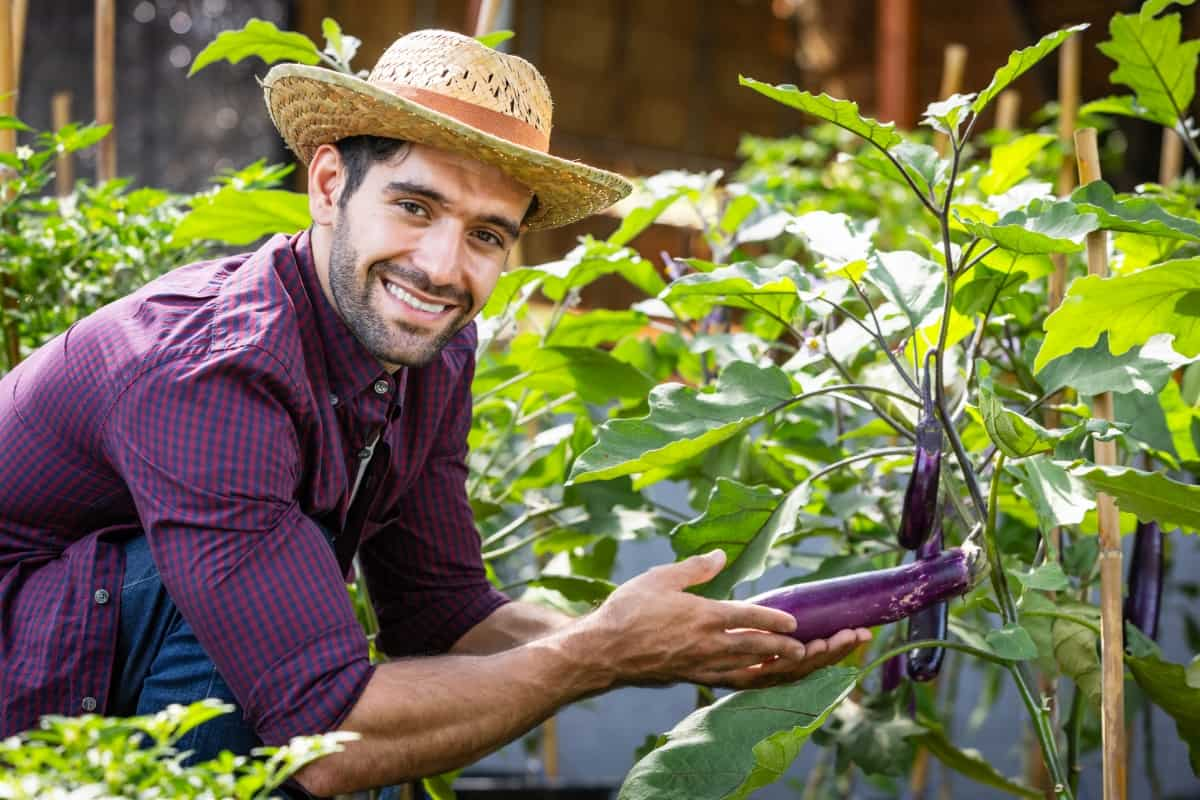
Types and Varieties of Eggplant
Different shapes, sizes, and colors characterize eggplants. Some popular types include the classic black beauty with its deep purple hue, the long and slender Japanese eggplant, and the small round fairy tale variety. Some other popular types include the classic purple Brinjal, long purple Brinjal, green Brinjal, white Brinjal, and even striped varieties. If you’re looking for something unique, consider trying out the white ghost or Turkish orange eggplant varieties. Each type has its distinct flavor profile and culinary uses.
Whether you prefer a mild taste or a slightly bitter one, there’s an eggplant variety to suit your preferences. The classic purple variety is widely recognized for its deep purple hue and versatile culinary uses. On the other hand, the long purple variety is favored for its elongated shape, which works well in stir-fries. Experimenting with different types of eggplants can add diversity to your farm produce and offer customers a wider selection to choose from at market stands or grocery stores.
Site Selection and Soil Preparation for Brinjal Cultivation
Select an area with full sunlight exposure for at least 6-8 hours a day. Brinjal plants thrive in warm temperatures, so make sure the site offers good ventilation and airflow. Start by plowing the land to break up any compacted soil layers. Remove any weeds or debris that could hinder plant growth.
Choose well-draining soil rich in organic matter to promote healthy growth. Make a soil test to check pH and nutrient content—aim for slightly acidic soil around pH 6-7. Properly preparing the soil sets the foundation for healthy plant growth and abundant harvests of delicious Brinjals later on.
Climate Considerations for Growing Brinjal
Brinjal thrives in warm temperatures and requires plenty of sunlight to flourish. Ideally, it should be grown in areas where the temperature level of 25°C and 30°C during the day and less than 15°C at night. Frost can be detrimental to Brinjal crops, so make sure to plant Brinjal after all risk of frost has passed.
In case you missed it: Brinjal Varieties and Diseases Information
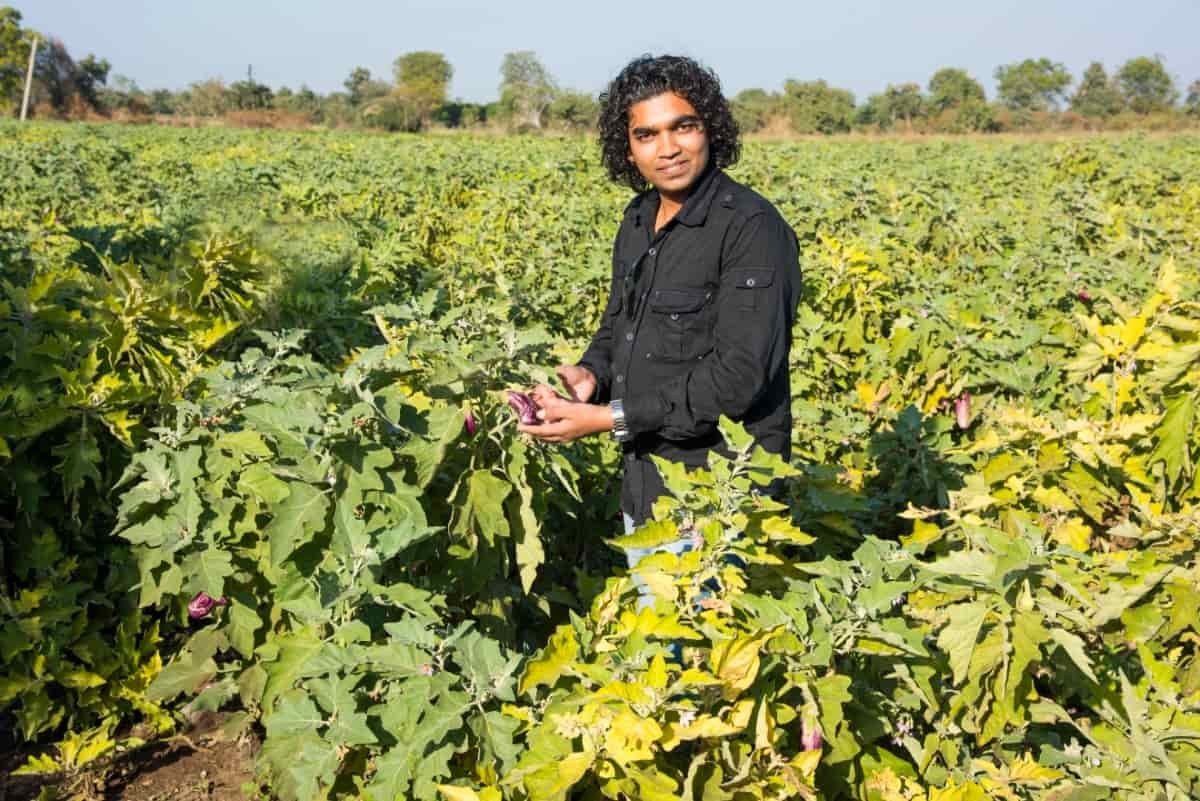
Brinjals are sensitive to extreme weather conditions such as heavy rainfall or strong winds. It’s important to provide adequate protection against these elements by using techniques like mulching or installing windbreaks. In regions with cooler climates, consider planting Brinjals in raised beds or using row covers to help retain heat and create a microclimate that is more conducive for growth.
Propagation Techniques: Seeds and Transplanting Methods
One of the methods used is through seeds. Starting with high-quality seeds is key to ensuring healthy plant growth. Before sowing the seeds, ensure they are from reputable sources and have good germination rates. Sow the Brinjal seeds at a depth of about 1 cm into the soil and cover lightly with more potting mix. Water carefully but thoroughly to provide moisture for germination. Locate the trays in a warm, sunny location or use grow lights if needed to help speed up germination.
Once your seedlings have developed true leaves, they can be transplanted into big containers or directly into your prepared garden bed for further growth and development toward a bountiful Brinjal harvest. Transplanting involves moving seedlings from their initial containers into the main field for further development. To start the process, prepare your seedlings by gently loosening them from their nursery beds or pots. Carefully lift the seedling with its root system intact to avoid any damage during transplantation.
Choose a suitable time for transplanting when the weather is favorable, and the soil has enough moisture. Avoid transplanting during extreme heat or rainy periods to minimize stress on the plants. Dig holes in your prepared field at appropriate distances based on the spacing requirements of Brinjal plants.
Place each seedling carefully into the hole and cover it with soil, ensuring that no air pockets remain around the roots. Water after transplanting helps settle the soil around the roots and provides hydration to support plant growth. Monitor your transplanted seedlings regularly for any signs of stress and adjust care as needed for optimal results in your Brinjal farming.
Planting Guide: Spacing, Depth, and Timing
The ideal spacing between plants ensures they have enough room to develop fully and receive adequate sunlight and nutrients. For standard Brinjal varieties, a spacing of about 24-36 inches between plants is recommended. On the other hand, smaller varieties may require slightly closer spacing, around 18-24 inches apart.
The depth at which you sow the seeds or transplant your seedlings plays a crucial role in their growth and development. The ideal depth for planting Brinjal seeds is around 0.5-1 cm deep in loose soil, that allows for proper root establishment. For transplanting, make sure to dig holes that are deep to accommodate the root ball of the seedling. Gently place the plant in the hole and cover it with soil, ensuring that no air pockets remain around the roots.
In case you missed it: Growing Brinjal in Pots or Containers
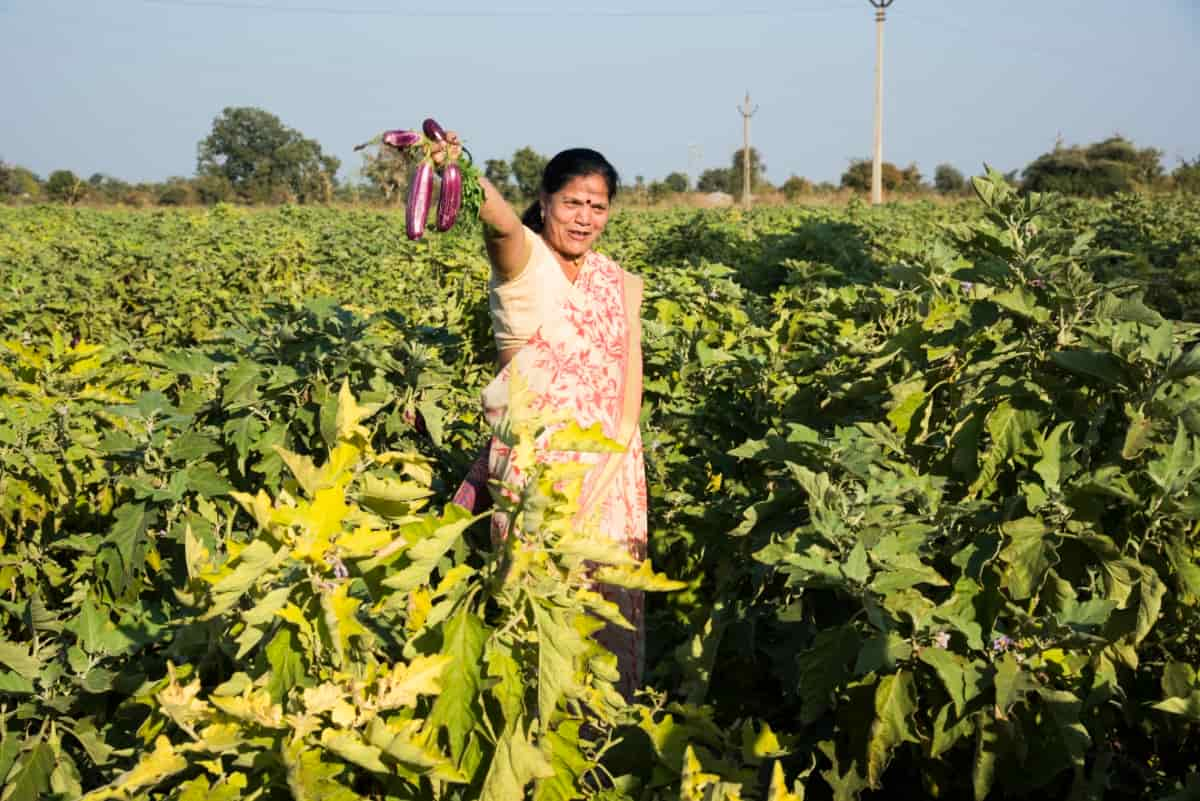
Planting at the right depth promotes strong root growth, which is essential for healthy Brinjal plants. It helps them withstand environmental stresses and absorb nutrients efficiently from the soil. The ideal time for sowing the seeds or transplanting seedlings depends on your climatic conditions. In warmer regions, early spring is optimal for planting, while in cooler areas, it’s best to wait until after the last frost. To determine the right timing for planting Brinjal in your area, consider factors like temperature trends and local growing seasons.
Nutrient Management: Fertilizer Requirements and Organic Options
Fertilizers play a major role in providing nutrients that promote plant growth and fruit development. Brinjals are heavy feeders, requiring a balanced supply of nutrients throughout their growth cycle. Nitrogen, phosphorus, and potassium are vital elements needed in the correct proportions for healthy plant growth.
Conventional fertilizers like NPK (Nitrogen, Phosphorus, and Potassium) can be used according to soil test recommendations to meet the crop’s specific needs. Compost or manure is also effective in enriching the soil with natural nutrients.
Organic fertilizers provide essential nutrients and also improve soil structure and enhance microbial activity, promoting long-term sustainability in Brinjal cultivation. Compost, manure, and plant-based materials not only provide essential nutrients but also improve soil health in the long run.
Compost is a great organic option rich in nutrients that promote the healthy growth of Brinjal plants. It helps retain soil moisture and encourages beneficial microbial activity. Animal manure is another excellent organic nutrient that can boost plant growth naturally.
Using cover crops like legumes or grasses as green manure is an effective way to enhance soil fertility organically. These cover crops add nitrogen back into the soil, enriching it without the need for synthetic chemicals. Additionally, incorporating biofertilizers containing beneficial microorganisms can further support plant growth and improve nutrient uptake.
Irrigation Techniques: Ensuring Optimal Water Supply
Ensuring optimal water supply is crucial for the growth and development of healthy eggplants. Adequate irrigation techniques play a vital role in maximizing yield and quality. Proper irrigation helps prevent water stress and promotes strong root systems. Drip irrigation or sprinkler systems are commonly used to water Brinjal plants efficiently.
These techniques ensure that water reaches the roots directly without being wasted. It’s important to monitor soil moisture regularly to avoid overwatering or underwatering. Adjusting irrigation based on weather conditions can help maintain an optimal water supply for your Brinjal crop.
Boosting Flowering in Eggplants
Boosting flowering is essential for a bountiful harvest. To encourage more blooms, make sure your plants receive adequate sunlight – they love soaking up the sun. Consider using organic fertilizers rich in phosphorus to promote flower development. Mulching around the plant base can help retain moisture and regulate soil temperature, creating a conducive environment for flowering.
In case you missed it: Eggplant Flower Drop, Reasons, Control Methods (Brinjal)
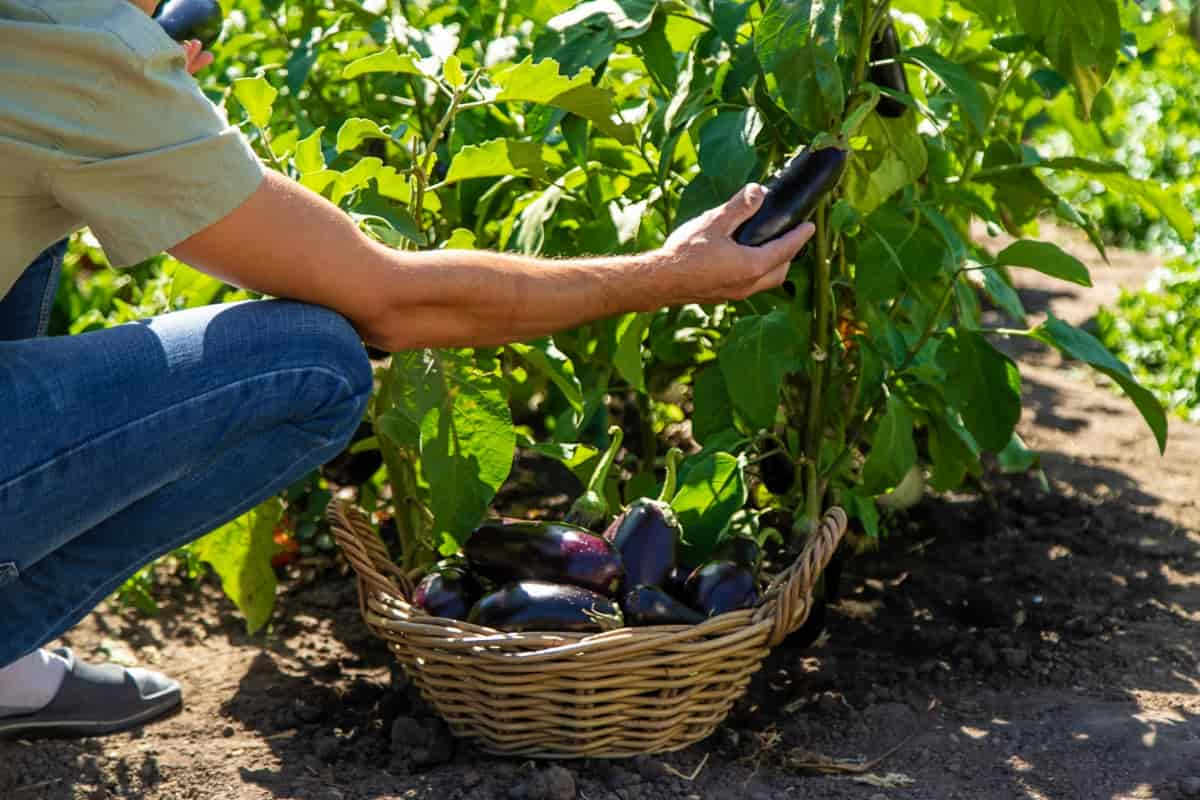
Pruning overcrowded branches can also redirect energy towards flower production. Check for pests and diseases that may hinder flowering. Also, look for signs of stress, such as yellowing leaves or wilting, which can impact flower formation. Maintaining consistent watering practices is crucial – too much or too little water can disrupt blooming patterns.
Pest and Disease Control Strategies for Brinjal
Pests and diseases can wreak havoc on Brinjal crops if not managed effectively. Some common pests to watch out for include fruit borer, shoot and fruit borer, aphids, whiteflies, and spider mites. These pesky invaders can cause significant damage to the plants if left unchecked. On the disease front, Brinjal is susceptible to fungal infections like early blight, bacterial wilt, powdery mildew, and damping-off disease. These diseases can stunt plant growth, reduce yield quality, or even kill the entire crop in severe cases.
Preventive measures like crop rotation, proper sanitation practices, and using resistant varieties when available are essential in combating these issues. Additionally, applying organic pesticides or biocontrol agents can help keep pests in check without harming beneficial insects. Regular monitoring for any signs of infestation or infection is important for early detection and prompt action.
Harvesting Methods: When and How to Harvest Eggplants
Knowing the right time to harvest eggplants is crucial for maximizing their flavor and quality. Typically, you can start harvesting when the fruit reaches a mature size and has a glossy appearance. An easy way to determine if an eggplant is ready for picking is to press your finger against the skin gently. If it leaves an indentation that bounces back slowly, it’s usually good to go. Avoid waiting too long before harvesting, as overripe eggplants may become bitter and develop tough skins. Once the fruits are ripe, harvest regularly to maintain consistent production.
In case you missed it: Fertilizer Management in Brinjal/Eggplant: Organic, Compost, How and When to Apply
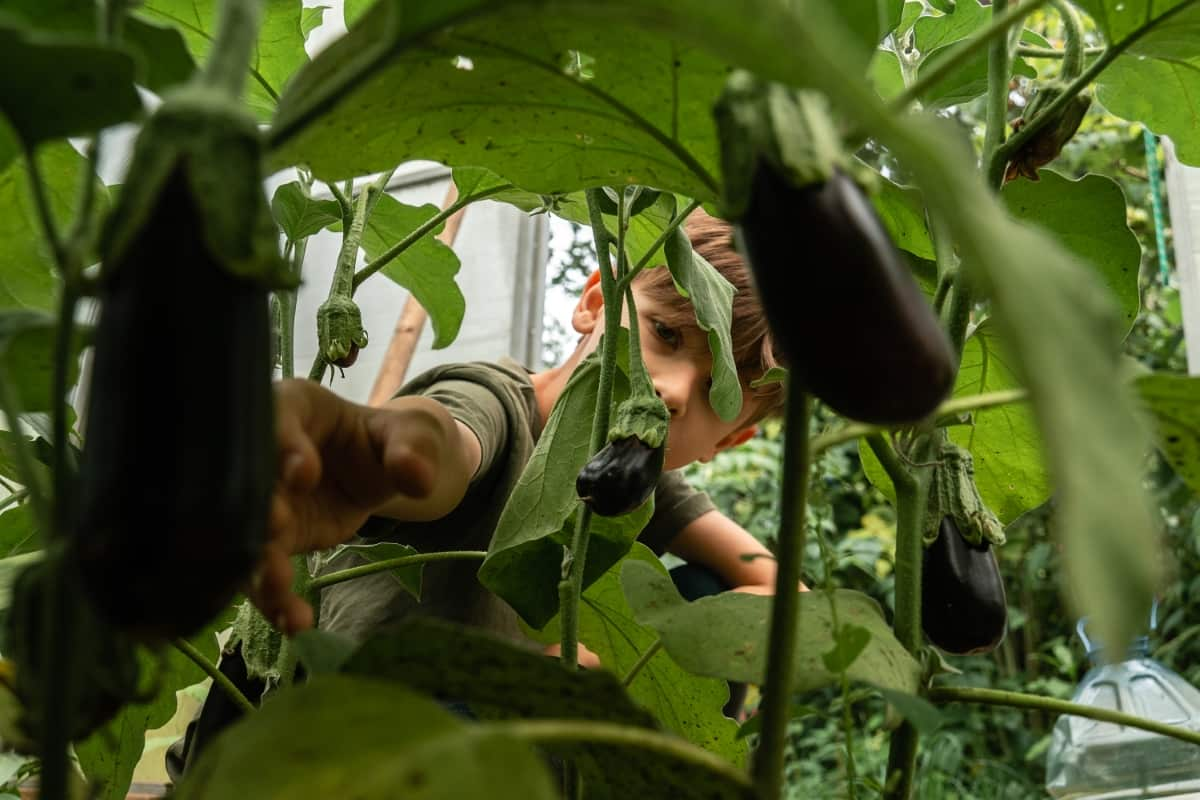
Use a knife or pruning shears to cut the Brinjal, leaving a small portion of the stem attached. Avoid pulling or twisting the eggplant off, as it can damage both the fruit and the plant. Harvest regularly to encourage continuous production throughout the growing season. Gently handle harvested eggplants to prevent bruising and extend their shelf life.
Yield per Acre
The yield per acre is a crucial factor that determines the success of your cultivation. On average, a well-managed Brinjal farm can produce approximately 15 to 20 tons of eggplants per acre. The yield varies based on factors like soil quality, climate conditions, and proper management practices. Harvesting at the right time when the fruits are firm and glossy also contributes to higher overall production. It’s essential to handle the harvested eggplants carefully to prevent any damage that could impact their market value.
Post-Harvest Handling of Brinjal
Once harvested, remove dirt or debris from the Brinjals. Avoid washing them unless necessary, as excess moisture can lead to spoilage. Check for any bruises or cuts that could accelerate decay. Properly ventilate the storage area to prevent mold growth and maintain freshness. Store Brinjals in a cool, dry place away from direct sunlight. The optimal temperature for storage is around 10-12°C.
In case you missed it: Top 15 Steps/Ways to Boost Eggplant/Brinjal Yield: How to Increase Production, Size, and Quality
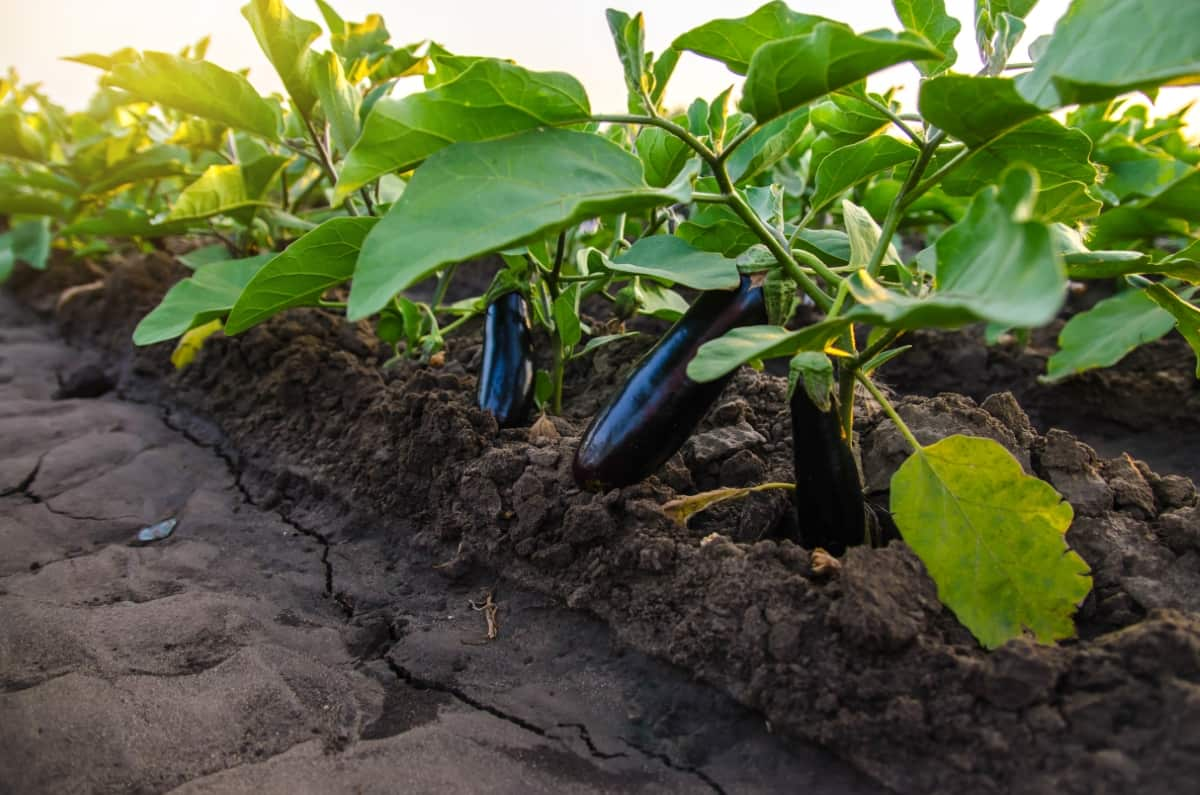
Consider using perforated plastic bags or containers with ventilation holes to keep them fresh longer. Regularly inspect stored Brinjals for signs of rotting or shriveling. Remove any spoiled ones immediately to prevent further contamination. Once the harvest is ready, a solid marketing strategy is essential to ensure that the produce reaches consumers effectively.
Marketing of Brinjal
One way to market Brinjals is by establishing direct relationships with local markets, grocery stores, and restaurants. By directly supplying to these outlets, farmers can guarantee fresh and high-quality produce for customers. Another effective marketing technique is participating in farmer’s markets or setting up stands at community events. This allows farmers to interact directly with consumers, educating them about the benefits of consuming Brinjals and creating brand awareness.
Utilizing online platforms can also broaden the reach of Brinjal products to a larger audience. Creating engaging content showcasing recipes or the health benefits of Brinjals can attract potential buyers. Moreover, collaborating with food bloggers or influencers who advocate for healthy eating habits can further promote Brinjal consumption among their followers.
Building partnerships like this can create additional avenues for marketing Brinjals effectively. By selecting the Brinjal variety appropriate to your region’s climate and soil conditions, you can optimize yield and quality. With the right approach, Brinjal cultivation can be a profitable and sustainable venture.
- Goat Farming Technology: The Future of Goat Husbandry
- How to Build a Low-budget Goat Shed: Cheap Ideas and Tips
- Goat Farming Training Programs in India: A Beginner’s Guide
- Types of Pesticides Used in Agriculture: A Beginner’s Guide
- Economical Aquaculture: A Guide to Low-Budget Fish Farming
- 15 Common Planting Errors That Can Doom Your Fruit Trees
- How to Make Houseplants Bushy: Effective Tips and Ideas
- Innovative Strategies for Boosting Coconut Pollination and Yield
- Pollination Strategies for Maximum Pumpkin Yield
- The Complete Guide to Chicken Fattening: Strategies for Maximum Growth
- Natural Solutions for Tulip Problems: 100% Effective Remedies for Leaf and Bulb-Related Issues
- Revolutionizing Citrus Preservation: Towards a Healthier, Greener Future
- Natural Solutions for Peony Leaf and Flower Problems: 100% Effective Remedies
- Maximizing Profits with Avocado Contract Farming in India: A Comprehensive Guide
- Natural Solutions for Hydrangea Problems: 100% Effective Remedies for Leaf and Flowers
- The Ultimate Guide to Choosing the Perfect Foliage Friend: Bringing Life Indoors
- From Sunlight to Sustainability: 15 Ways to Use Solar Technology in Agriculture
- The Ultimate Guide to Dong Tao Chicken: Exploring from History to Raising
- The Eco-Friendly Makeover: How to Convert Your Unused Swimming Pool into a Fish Pond
- Mastering the Art of Delaware Chicken Farming: Essentials for Healthy Backyard Flocks
- 20 Best Homemade Fertilizers for Money Plant: DIY Recipes and Application Methods
- How to Craft a Comprehensive Free-Range Chicken Farming Business Plan
- Brighten Your Flock: Raising Easter Egger Chickens for Beauty and Bounty
- How to Optimize Your Poultry Egg Farm Business Plan with These Strategies
- Subsidy for Spirulina Cultivation: How Indian Government Schemes Encouraging Spirulina Farmers
- Ultimate Guide to Raising Dominique Chickens: Breeding, Feeding, Egg-Production, and Care
- Mastering the Art of Raising Jersey Giant Chickens: Care, Feeding, and More
- Ultimate Guide to Raising Legbar Chickens: Breeding, Farming Practices, Diet, Egg-Production
- How to Raise Welsummer Chickens: A Comprehensive Guide for Beginners
- How to Protect Indoor Plants in Winter: A Comprehensive Guide
- Ultimate Guide to Grow Bag Gardening: Tips, Tricks, and Planting Ideas for Urban Gardeners
- Guide to Lotus Cultivation: How to Propagate, Plant, Grow, Care, Cost, and Profit
- Agriculture Drone Subsidy Scheme: Government Kisan Subsidy, License, and How to Apply Online
- Ultimate Guide to Raising Araucana Chickens: Breed Profile, Farming Economics, Diet, and Care
- Bringing Hydroponics to Classroom: Importance, Benefits of Learning for School Students
- Ultimate Guide to Raising Polish Chickens: Breed Profile, Farming Economics, Diet, and Care
ನಿಮ್ಮ ಈ ಮಾಹಿತಿಯು ಪ್ರತಿಯೊಬ್ಬ ರೈತರಿಗೂ ಉಪಯೋಗವಾಗುತ್ತದೆ. ಧನ್ಯವಾದಗಳು ಸರ್